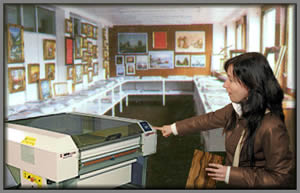Lately I have made a decision to finish with the commercial production of standardised marquetry designs for furniture decoration and I will be turning my hand to something much more creative in connection with my commercial products.
I first started doing marquetry with a big electric saw machine, something rather like a very large fret or piercing saw. It was very tedious work you know... preparing pressed packets with different veneers... To be honest, I have to say that it got on my nerves dealing with the extremely thin hair saw blades that kept breaking every 10 minutes. Plus, of course it was not at all economical using so many veneers and then ultimately ending up getting loads of waste.
I eventually replaced the electric fret saw for a laser cutter machine, what a wonderful difference this is definitely my very best friend! There are several models in the market. The laser cutter produces a line of fire in the form of a beam of concentrated light that burns your design right through the veneer like a very well controlled sharp hot blade. It is so exact that it will give the precision cutting power in one optimum point as fine as a scalpel blade point. There are only two parameters that need to be controlled, namely the "Speed" and the "Power". A good analogy of those speed and power settings is to compare the dispersed heat you would get from say, being 3 minutes in the middle of a large bonfire to the concentrated heat attained in 1 second from touching the flame of a lit match.
The main advantage of the laser cutting machine is that you can cut your required design very quickly and with extremely high precision. This means that you can change your veneers and or designs very easily without the usual problems if you find you’re not too happy with your first results. You could quite easily do a complete series of pictures just by simply pressing a button. The laser marquetry cutter allows you to have the added advantage of entering the commercial market with genuinely reasonable prices. Yet another advantage is that the laser cutter will totally and accurately replicate your design so that it will cut several identical pieces from a sheet of veneer getting the best profile without wastage of the veneer. Something else really interesting is that you could write or draw dark markings on the veneers in a similar fashion to "Pirography" but, of course, much more precisely.
|
The laser cutter in operation
|
With regard to disadvantages, it is an expensive machine, and would only be profitable if you get an economical result.
You do also need to have some computer skills and you will need to understand vector design techniques.
Sometimes a thin darkish shadow caused by the heat of the laser beam can appear in the edges of the cutting line of pale veneers such as sycamore.
The cutting however is incredibly fast but you still need to use some tweezers to assemble all the pieces together to make your final design.
You cannot unfortunately cut pieces smaller than 4 mm2, so the laser cutting machine would not really be suitable for the kind of pictures I saw at the 2007 National. |
As I noticed at the National Exhibition, you all seem to give great importance to the skilful, difficulty, the craft... it’s the technical aspect of marquetry that often seems to be the most favoured side of the art. Furthermore there are several articles from the Marquetarian that seem to tie you into valuing the most traditional of manners... (such as trying not to use dyed veneers... and so on).
Personally, I am mainly interested in the natural qualities of the wood itself, these being such things as the figuring, colouring and grain pattern occurring naturally in the veneers I use. I like to investigate, and add as many variables and options as I can to my artistic projects. I cannot imagine how the new inventions and discoveries in the world of marquetry will pan out over the next 50 years, but there will surely be something and I hope to be able to adopt them and have the right opportunities to use them.
Cuadro Juanma
A laser cut marquetry picture by Susana Bartolomé
Of course, to do new things for the future it is equally essential to control the old things from the past, but I'm hardly at that point yet.
I’d like to give my thanks to the Marquetry Society for its generous nature of freely spreading the marquetry message to an eager world. There's nothing similar to the Marquetry Society here in Spain, the place where I come from and live.
So remember, if you need more than 20 pieces...of furniture...or pictures...focus on to a very convenient market... Contact me! I'll do it in a minute!!!!
|



